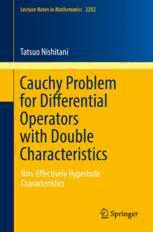Table Of ContentLecture Notes in Mathematics 2202
Tatsuo Nishitani
Cauchy Problem
for Differential
Operators
with Double
Characteristics
Non-Effectively Hyperbolic
Characteristics
Lecture Notes in Mathematics 2202
Editors-in-Chief:
Jean-MichelMorel,Cachan
BernardTeissier,Paris
AdvisoryBoard:
MichelBrion,Grenoble
CamilloDeLellis,Zurich
AlessioFigalli,Zurich
DavarKhoshnevisan,SaltLakeCity
IoannisKontoyiannis,Athens
GáborLugosi,Barcelona
MarkPodolskij,Aarhus
SylviaSerfaty,NewYork
AnnaWienhard,Heidelberg
Moreinformationaboutthisseriesathttp://www.springer.com/series/304
Tatsuo Nishitani
Cauchy Problem
for Differential Operators
with Double Characteristics
Non-Effectively Hyperbolic Characteristics
123
TatsuoNishitani
DepartmentofMathematics
OsakaUniversity
Toyonaka,Osaka
Japan
ISSN0075-8434 ISSN1617-9692 (electronic)
LectureNotesinMathematics
ISBN978-3-319-67611-1 ISBN978-3-319-67612-8 (eBook)
DOI10.1007/978-3-319-67612-8
LibraryofCongressControlNumber:2017954399
MathematicsSubjectClassification(2010):35L15,35L30,35B30,35S05,34M40
©SpringerInternationalPublishingAG2017
Thisworkissubjecttocopyright.AllrightsarereservedbythePublisher,whetherthewholeorpartof
thematerialisconcerned,specificallytherightsoftranslation,reprinting,reuseofillustrations,recitation,
broadcasting,reproductiononmicrofilmsorinanyotherphysicalway,andtransmissionorinformation
storageandretrieval,electronicadaptation,computersoftware,orbysimilarordissimilarmethodology
nowknownorhereafterdeveloped.
Theuseofgeneraldescriptivenames,registerednames,trademarks,servicemarks,etc.inthispublication
doesnotimply,evenintheabsenceofaspecificstatement,thatsuchnamesareexemptfromtherelevant
protectivelawsandregulationsandthereforefreeforgeneraluse.
Thepublisher,theauthorsandtheeditorsaresafetoassumethattheadviceandinformationinthisbook
arebelievedtobetrueandaccurateatthedateofpublication.Neitherthepublishernortheauthorsor
theeditorsgiveawarranty,expressorimplied,withrespecttothematerialcontainedhereinorforany
errorsoromissionsthatmayhavebeenmade.Thepublisherremainsneutralwithregardtojurisdictional
claimsinpublishedmapsandinstitutionalaffiliations.
Printedonacid-freepaper
ThisSpringerimprintispublishedbySpringerNature
TheregisteredcompanyisSpringerInternationalPublishingAG
Theregisteredcompanyaddressis:Gewerbestrasse11,6330Cham,Switzerland
Preface
Inthe early1970s,V.Ja. Ivriiand V.M.Petkovintroducedthefundamentalmatrix
F , which is now called the Hamilton map, at double characteristic points of the
p
principal symbol p of a differential operator P and proved that if the Cauchy
problem for P is C1 well-posed for any lower order term then at every double
characteristic point F has non-zero real eigenvalues; such characteristic is now
p
called effectively hyperbolic. If no real eigenvalue exist, that is non-effectively
hyperbolic, they proved, under some restrictions, the subprincipal symbol must
lie in some interval on the real line for the Cauchy problem to be C1 well-
posed. This necessary condition for the C1 well-posedness at non-effectively
hyperbolic characteristic point was completed soon afterwards and is now called
theIvrii–Petkov–Hörmandercondition(IPHconditionforshort).Inthismonograph
we provide a general picture of the Cauchy problem for differential operators
with double characteristics exposing well/ill-posed results of the Cauchy problem
withnon-effectivelyhyperboliccharacteristicsobtainedsince1980s,with detailed
proofs.
Thismonographisorganizedasfollows.InChap.1,aftergivingabriefoverview
on the C1 well-posedness of the Cauchy problem and a quick introduction to
pseudodifferential operators we review basic results and notion about hyperbolic
doublecharacteristics.In Chap.2, wepresentdetaileddiscussionsonthe behavior
of principal symbols p near non-effectively hyperbolic characteristics. We prove
that p admits a nice microlocal factorization for deriving energy estimates if the
cubeofsomespecifiedvectorfieldannihilatesp.InChap.3weprovethatpadmits
this factorization if and only if there is no bicharacteristic tangent to the double
characteristicmanifold.InChap.4weproposeenergyestimatessuchthatifatevery
point(cid:2)inthephasespacethereisP(cid:2) coincidingwithPinaconicneighborhoodof
(cid:2) for which these proposedenergyestimates holdthen the Cauchy problemfor P
is locally solvable. In Chap.5 we provemain results on the well-posednessof the
Cauchyproblemwhichcouldbestated:ifthereisnotangentbicharacteristicsand
notransitionofthespectraltypeof F thentheCauchyproblemisC1 well-posed
p
underthe strict IHP condition.In Chap.6 we exhibitan example of second order
differentialoperatorwithpolynomialcoefficients,verifyingtheLevicondition,with
v
vi Preface
tangent bicharacteristic and no transition of the spectral type of F for which the
p
Cauchyproblemisill-posedintheGevreyclassoforders > 5,andofcourseC1
ill-posed. In Chap.7 we confirm the optimality of this Gevrey class proving that
the Cauchy problem for P is well-posed in the Gevrey class of order 5 under the
Levicondition,assumingno transitionof the spectraltype.Finally in Chap.8, for
thesameoperatorstudiedinChap.6,weprovethattheCauchyproblemisC1 ill-
posed for any choice of lower order term, more strongly, ill-posed in the Gevrey
classoforders>6foranylowerorderterm.
OtsuinDecember2016 TatsuoNishitani
Contents
1 Introduction .................................................................. 1
1.1 CauchyProblem,anOverview......................................... 1
1.2 SobolevSpaces.......................................................... 5
1.3 PseudodifferentialOperators ........................................... 6
1.4 AReviewonHyperbolicDoubleCharacteristics ..................... 9
1.5 HyperbolicQuadraticFormsonaSymplecticVectorSpace.......... 16
2 Non-effectivelyHyperbolicCharacteristics............................... 25
2.1 CaseofSpectralType1................................................. 25
2.2 CaseofSpectralType2................................................. 31
2.3 VectorFieldH andKeyFactorization................................. 35
S
3 GeometryofBicharacteristics.............................................. 43
3.1 BehaviorsofBicharacteristics.......................................... 43
3.2 ExpressionofpasAlmostSymplecticallyIndependentSums ....... 47
3.3 Reduction of the Hamilton Equation to a Coupling
SystemofODE.......................................................... 53
3.4 ExistenceofTangentBicharacteristics................................. 59
3.5 TransversalBicharacteristics........................................... 64
4 MicrolocalEnergyEstimatesandWell-Posedness ....................... 71
4.1 ParametrixwithFinitePropagationSpeedofMicroSupports........ 71
4.2 EnergyEstimate.E/andExistenceofParametrix.................... 79
4.3 EnergyEstimate.E/andFinitePropagationSpeedofMicro
Supports ................................................................. 90
5 CauchyProblem:NoTangentBicharacteristics.......................... 95
5.1 MainResultsonWell-Posedness....................................... 95
5.2 EnergyIdentity.......................................................... 98
5.3 MicrolocalEnergyEstimates,SpectralType1 ........................ 101
5.4 MicrolocalEnergyEstimates,SpectralType2 ........................ 107
5.5 CaseofSpectralType2withZeroPositiveTrace..................... 112
5.6 CaseofSpectralType1withZeroPositiveTrace..................... 116
vii
viii Contents
5.7 ProofofMainResults................................................... 120
5.8 Melin-HörmanderInequality........................................... 123
6 TangentBicharacteristicsandIll-Posedness.............................. 129
6.1 NonSolvabilityinC1 andintheGevreyClasses .................... 129
6.2 ConstructionofSolutions,ZerosofStokesMultipliers............... 131
6.3 ProofofNonSolvabilityoftheCauchyProblem ..................... 137
6.4 OpenQuestionsandRemarks.......................................... 141
7 CauchyProblemintheGevreyClasses.................................... 149
7.1 PseudodifferentialOperators,Revisited ............................... 149
7.2 PseudodifferentialWeightsandFactorization ......................... 151
7.3 ALemmaonCompositionwithe˙hDi(cid:3) ................................ 159
7.4 WeightedEnergyEstimates ............................................ 165
7.5 Well-PosednessintheGevreyClasses................................. 171
8 Ill-PosedCauchyProblem,Revisited...................................... 181
8.1 Preliminaries ............................................................ 181
8.2 AsymptoticSolutions................................................... 183
8.3 EstimatesofAsymptoticSolutions,Majorant......................... 186
8.4 APrioriEstimatesintheGevreyClasses.............................. 191
8.5 ProofofIll-PosedResults .............................................. 194
8.6 NonStrictIPHCondition,AnExample ............................... 197
References......................................................................... 203
Index............................................................................... 209
Chapter 1
Introduction
Abstract Inthischapter,afterquicklyreviewingthebackgroundwhichmotivates
to prepare this monograph we state basic facts on pseudodifferential operators
withoutproofs,exceptforafewresults.WethenrecallbasicresultsontheCauchy
problemfordifferentialoperatorswithdoublecharacteristics,includingbasicnotion
and resultsaboutdoublecharacteristicsof hyperbolicpolynomialsand hyperbolic
quadraticformswhichwillbeusedthroughoutthemonograph.
1.1 CauchyProblem, an Overview
LetPbea differentialoperatoroforderm definedinaneighborhoodofxN 2 RnC1
andlett Dt.x/bearealvaluedsmoothfunctiongiveninaneighborhoodofxN with
t.xN/ D 0.WeassumethatPisnon-characteristicwithrespecttoH D ft.x/ D0gat
xN,thatis.Ptm/.xN/ ¤ 0.Letu0.x/;:::;um(cid:2)1.x/bem-tuplesofsmoothfunctionson
H definednear xN then the Cauchy problemis that of findingu, in a neighborhood
of xN, satisfying Pu D 0 near xN and .@=@(cid:4)/ju.x/ D u.x/, j D 0;:::;m(cid:2)1 on H
j
where(cid:4) istheunitnormaltoH.Here.u0;:::;um(cid:2)1/iscalledtheinitialdataorthe
Cauchydata.Roughlyspeaking,theCauchyproblemissaidtobeE well-posedin
thedirectiontifforanyinitialdatainE,whichisafunctionspacegivenbeforehand,
thereexistsa uniquesolutionto theCauchyproblem,andthedifferentialoperator
forwhichtheCauchyproblemiswell-posedinthedirectiontiscalledhyperbolicin
thisdirection.ChoosingasystemoflocalcoordinatesxD.x0;x0/D.x0;x1;:::;xn/
sothatt.x/Dx0,xN D0anddividingPbyanonvanishingfunctionwehave
X Xm
PDDm0 C a˛.x/D˛ D Pj
j˛j(cid:3)m;˛0<m jD0
P
in these coordinates where Pj D j˛jDja˛.x/D˛ denotes the homogeneous part
of P of degree j and D D .D0;D0/ D .D0;D1;:::;Dn/, Dj D (cid:2)i@=@xj,
D˛ D D˛00(cid:3)(cid:3)(cid:3)D˛nn, ˛ D .˛0;:::;˛n/ 2 NnC1. The homogeneous polynomial in
©SpringerInternationalPublishingAG2017 1
T.Nishitani,CauchyProblemforDifferentialOperatorswithDouble
Characteristics,LectureNotesinMathematics2202,
DOI10.1007/978-3-319-67612-8_1

